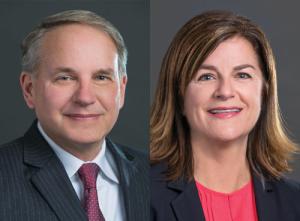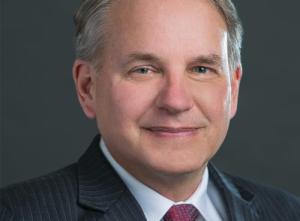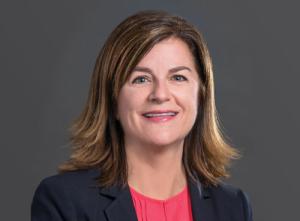PPL Corp.
Greg Dudkin is COO of PPL Corp. Stephanie Raymond is President of PPL Electric Utilities.
Electric Power, Arizona Public Service, Evergy, Northwestern Energy, PPL Corporation, WEC Energy Group, and Xcel Energy, as outlined below by execs from these companies, have quite decisively accelerated their progress on ESG priorities, through investment, innovation, and a clear intent to be recognized as leaders in ESG at the same time that they continue to deliver safe, reliable, and affordable utility service to the communities that depend upon them, powerfully.

PUF's Steve Mitnick: Steph, PPL Electric Utilities has been very focused on building a smarter, more dynamic grid. Talk about your efforts and progress in this area.
Steph Raymond: If we go back ten years to when we launched our grid modernization, our initial focus was on reliability. And over the last decade, we have spent much of our time investing in the grid to make it more reliable and to improve power quality for our customers.
Early on, we recognized that our grid was aging, creating reliability issues, and we saw an opportunity to not only replace these aging assets, but to invest in smart grid technology and automation to strengthen grid resilience.
Since then, we've added thousands of smart grid devices, including sensors and switches, and incorporated distribution automation on every circuit in PPL Electric Utilities' system. As a result, today we have one of the most advanced distribution networks in the country. We've significantly reduced the average age of our assets.
 Greg Dudkin: As we plan for PPL’s acquisition of The Narragansett Electric Company, we believe our experience in automating electricity networks can help Rhode Island achieve its target of 100% renewable energy by 2030 and net-zero carbon emissions by 2050.
Greg Dudkin: As we plan for PPL’s acquisition of The Narragansett Electric Company, we believe our experience in automating electricity networks can help Rhode Island achieve its target of 100% renewable energy by 2030 and net-zero carbon emissions by 2050.
For example, we've cut the average age of our transformers by more than half. Since 2015, we've been able to prevent more than 1.2 million power outages for our customers by quickly and automatically rerouting power in the event of a problem.
As our smart grid efforts evolved, we saw an opportunity to expand on the capabilities and technology we had deployed and to build a smart delivery platform to enable the connection of more distributed energy resources. We've since deployed a state-of-the-art distributed energy resource management system to reliably and efficiently manage the two-way flow of power created by DERs.
PUF: You mentioned the reliability benefits your smart grid investments have provided. Talk more about the benefits of your work to enable more distributed energy resources.
Steph Raymond: Adding more DERs to the grid requires smarter, more dynamic networks that support and manage the two-way flow of power and automatically balance supply and demand as intermittent renewable generation increases.
 Steph Raymond: We’ve added thousands of smart grid devices, including sensors and switches, and distribution automation on every circuit. We have one of the most advanced distribution networks in the country. We’ve deployed a state-of-the-art DERMS.
Steph Raymond: We’ve added thousands of smart grid devices, including sensors and switches, and distribution automation on every circuit. We have one of the most advanced distribution networks in the country. We’ve deployed a state-of-the-art DERMS.
We've built our distributed energy resource management system to do just that, which benefits customers and keeps service reliable. Beyond these benefits, however, building this new platform also included building a portal for our customers to engage with us.
In the past, if a solar customer wanted to connect to our grid, that took a long time with deep engineering and lots of planning. Part of our strategy was to say, we need to make this easier, faster, and better. With this in mind, we deployed a portal for customers who were applying to connect DERs.
Since we deployed the portal in 2018, we've had five thousand applications for connection. We've been able to turn ninety percent of those around in twenty-four hours.
Our distributed energy resource management system has also provided additional benefits. For example, we recently had a commercial customer who wanted to bring three megawatts of solar onto our system. That would've cost our customer 1.2 million dollars because it was going to require us to do some grid reinforcement.
We asked if they would hook up through a smart inverter onto our DERMS platform so we could manage their power flow. They agreed, and we were able to reduce their costs significantly. We saved the customer seven hundred thousand dollars by hooking up to us and saying, let us manage your information for you.
PUF: How do data, technology, and analysis fit into your broader smart grid efforts?
Steph Raymond: It's core to it all. Now, with sensors throughout our system, we are able to collect a tremendous amount of data. We're in the process of determining if we can use data to help us build algorithms for outage prediction.
We have one of the most advanced vegetation management programs because we are using data. We've been able to refine which trees need trimming because we're using data. These are just some of the ways we've been able to put data to work for our customers.
Over the last five years, we have achieved top-decile reliability performance, and it's because we're using data to make better decisions. That's our future.
Greg Dudkin: I would add that there are a lot of sensors on our system. Where we see this going is that sensors will bring back data. We will have algorithms based on that real-time data to predict whether there's a problem about to happen.
That algorithm will kick out a work order automatically, and we'll be able to send people out to fix the issue before it becomes a problem. The end result is we'll be able to have better service at a lower cost, and that's what we're shooting for.
PUF: Greg, how do you see PPL's smart grid initiatives supporting the company's broader work to advance a clean energy future?
Greg Dudkin: In August, PPL set a new goal to achieve net-zero carbon emissions by 2050. And as we pursue our emissions goals and work to advance the clean energy transition more broadly, we know technology is going to have a big role to play.
A clear benefit of our smart grid investment is that, with the smart sensors and equipment we've put on the grid, we will be able to host more solar on our circuits and feeders than most other utilities. We'll have data to make better operational decisions.
We'll also be able to manage more without having to invest as much in our distribution and transmission systems. We'll be able to keep our costs down while allowing more DER on our grid. That is a huge benefit.
As we plan for PPL's acquisition of The Narragansett Electric Company in Rhode Island, we're also excited about the potential to help that state achieve its ambitious decarbonization goals. We believe our experience in automating electricity networks can help the state achieve its target of one hundred percent renewable energy by 2030 and net-zero carbon emissions by 2050.
PUF: Put this in the bigger context of what's going on in ESG overall at PPL.
Greg Dudkin: I mentioned PPL's net-zero emissions goal, which reflects our strong commitment to advancing a cleaner energy future. Along with this new goal, we've set interim emissions reduction targets of eighty percent from 2010 levels by 2040 and seventy percent by 2035.
This summer, we also kicked off an initiative to enhance PPL's clean energy transition strategy.
We're working closely with a global consulting firm to develop a strategy that positions us for long-term growth in the clean energy transition.
At the same time, we continue to support research and development of clean energy technologies. In July, we announced we're investing up to fifty million dollars in Energy Impact Partners' global investment funds to accelerate the shift to a low-carbon future.
We're anchor sponsors of the Low-Carbon Resources Initiative being led by EPRI and the Gas Technology Institute. In addition, we recently announced a new partnership with the University of Kentucky Center for Applied Energy Research to study capture of carbon dioxide emissions at natural gas combined cycle power plants.
On the social side of ESG, we have always had strong focus in this area, but in the last year, we've made significant strides in the area of diversity, equity and inclusion. We have many efforts underway to make sure we are providing an environment for our employees that is inclusive of everyone, where everybody can achieve their full potential. Externally, we continue to provide strong support for the communities we serve.
In the governance space, we named a new independent board chair this spring, Craig Rogerson.
In October, we announced the addition of Heather Redman to PPL's board. She will be an outstanding addition to our very diverse and experienced board, bringing her significant experience in disruptive technologies, industry transformation, and energy technology.
PUF: Much of what we've talked about centers around technology and innovation. How has PPL been able to develop this culture of innovation?
Greg Dudkin: Ten or more years ago, we set a goal that we wanted to be top of the heap, at least top quartile in safety, reliability, customer satisfaction, and cost efficiency.
We've tried things. Some haven't worked, but a lot have, and they've been consequential. As an organization, we're starting to see we're making movement in all four areas.
It's momentum that builds on itself. Sort of like a flywheel. Our employees are excited to be part of an organization that is trying new things in order to achieve industry-leading performance in those four areas. That's what's driving it.
Steph Raymond: When I came to PPL, I was surprised at the level of information sharing. We also have no problem benchmarking. If we find areas where there's a gap and we see someone who does it better than us, we will benchmark.
It's about trying to learn what others are doing and how can we get better. And there's also a competitiveness in PPL in that we set high targets for ourselves and drive to achieve those results.
I'd also say diversity, equity and inclusion is a key factor. We believe we cannot get to our targets unless we have a diverse and inclusive workforce that enables people.
We want people to show up and do their best every single day, be heard, and have a voice. What we're seeing now is a breakthrough around innovation because of our efforts to foster a more diverse and inclusive workforce.
PUF: Talk about where all of this is going in the next few years.
Greg Dudkin: There's a lot of talk in the industry about the utility of the future. We're in the midst of building it.
In the future, what you're going to see is continuous two-way flow of power. Managing the grid is going to be more complicated, and technology will play a key role. That extends from generation to behind the meter. If you're able to utilize and leverage all those resources, you'll provide a better product to the customer at a lower cost, and that's our goal.
ESG Powerfully conversations, some with Guidehouse's Dan Hahn and Michelle Fay:
- AEP Managing Director - corporate sustainability Sandy Nessing
- Arizona Public Service VP Ann Becker
- Evergy General Counsel Heather Humphrey and Chief Compliance Officer Ellen Fairchild
- NorthWestern Energy COO Brian Bird
- PPL Corp. COO Greg Dudkin and PPL Electric Utilities President Stephanie Raymond
- WEC Energy Group SVP Beth Straka
- Xcel Energy SVP Frank Prager


